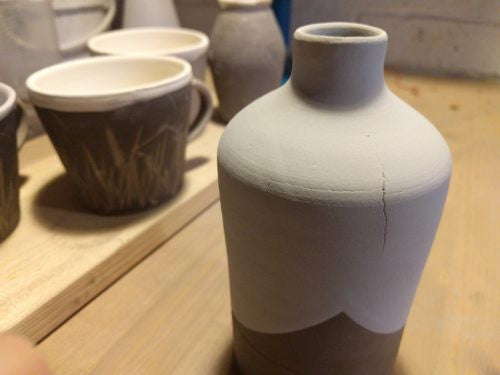
Raw Glazing and Single Firing Experiment
Share
I’ve decided to try and eliminate bisque firing by raw glazing pottery. Most potters nowadays do a bisque firing, which partially bakes the pottery so it can no longer return to mud. This makes glazing easier, before a second glaze firing takes place.

I’ve read about single firing before and it seems fraught with difficulty. It involves applying a water based glaze to semi or fully dried clay which will immediately want to dissolve. Furthermore, the coating of glaze inhibits the release of water and impurities from the clay during firing which increases the likelihood of explosions and kiln damage.
The advantages are the savings in energy by only doing one firing, and also the time saved loading, unloading and babysitting a bisque firing.
With bisque firing ware can be stacked and crammed into the kiln, as unglazed pots will not stick to each other. A glaze firing requires everything to be separated. This means on average one of my bisque firings will produce enough pottery for two glaze firings. The immediacy of creating pottery is dulled during the process. Maybe it’s because I’m on a learning curve, but I seem to be disinterested in the second glaze firing by the time it comes around.
By single firing the pottery could potentially be thrown, decorated, glazed and fired in a very short period.
I was reminded of raw glazing while watching a YouTube clip of Issac Button from 1965. He was an amazingly skilled and fast potter, and the Soil Hill pottery was in Halifax, not far from my childhood home in Huddersfield.
Opinions seem to differ about the benefits of glazing the pot in a leather hard or bone dry state. There is also different methods of glazing the inner and outer parts separately, or at the same time. I decided to experiment with all methods as it seems success will vary depending on clay body, glaze recipe and other factors.
I’ve read the percent of clay in a glaze is important for raw glazing, due to shrinkage. And also that clay bodies and glazes with lots of ball clay perform better for once firing. I’ve decided to just work with what I’ve been using to begin with, and try and keep variables down by using two glazes. One clear glaze, and one matt green glaze which I have adapted from the Digital fire base glazes.
Most of the pots are in a near bone dry state, I decided to pour glaze on the interior, and pour it out, let them dry out over a couple of days and them brush on glaze on the exterior. This process has been the most successful on inspection of the unfired pottery. The interiors look similar in coverage to my bisque glazing. I’m not sure if the brushed exteriors will look as smooth as a dipped pot, but time will tell.

I tried to raw glaze one piece that was fairly wet leather hard. On this pot the glaze cracked quite soon after application. It is a fine crack that can be touched up and I think would be unnoticeable after firing.

For one mug I had poured the interior, dried it out then tried to dip the exterior. This went horribly wrong, with masses of glaze on the outside, and bubbling and cracking on the inside. I did keep it in the glaze far too long, as the bucket was low on glaze and I struggled to cover up to the base of the pot.

Had the mug been bisque fired I could have just washed the glaze off and started again. As it wasn’t I’ll probably just bin it, I know it will look terrible after firing.
I’ve now written an update of single firing results.
Raw glazing and once firing resources
A page by Rik Midgley with some great info on raw glazing techniques
A YouTube playlist with some good videos on raw glazing.

4 comments
Hi, what during sequence would you recommend for a single firing in an electric kiln? Thanks
Hi! I would also love to see your work! I am trying ro run a community art project using single firing and a clear glaze only…largely due to logistics of getting people back to glaze their work.
Hi Rod. Thanks for your message. I’ve been reading the book Simon suggested and hope to try single firing again soon. Thanks for your tips, i may try the gum Arabic and painting glaze. 10k of thrown clay?! That’s huge. I’d love to see your pics, please send to address on contact page.
Hi, I just came across this, so kind of a late reply. As a hobby potter I used single firing for stoneware and porcelain for about 20 years. I made about 100 pots per year. I did it that way because my hero Lucie Rie did it that way (so whatever anyone else says it has to be OK when you look at her stuff)
She added gum arabic to the glaze which helps it to stick – it burns off in the firing. She glazed when the pots were bone dry, which does mean that you have to be careful handling them. I used to brush on most glaze rather than dipping or pouring. Two reasons; you don’t have to make so much glaze and handling the pot is easier. I made all shapes and sizes up to about ten kilo of thrown clay. I’ve read that the failure rate is higher, but almost all of mine worked.
I could send you pictures if you want. I don’t throw now. My studio was wrecked by floods a while back and what with the arthritis and a few other things I collected the money from the insurance and called it a day.